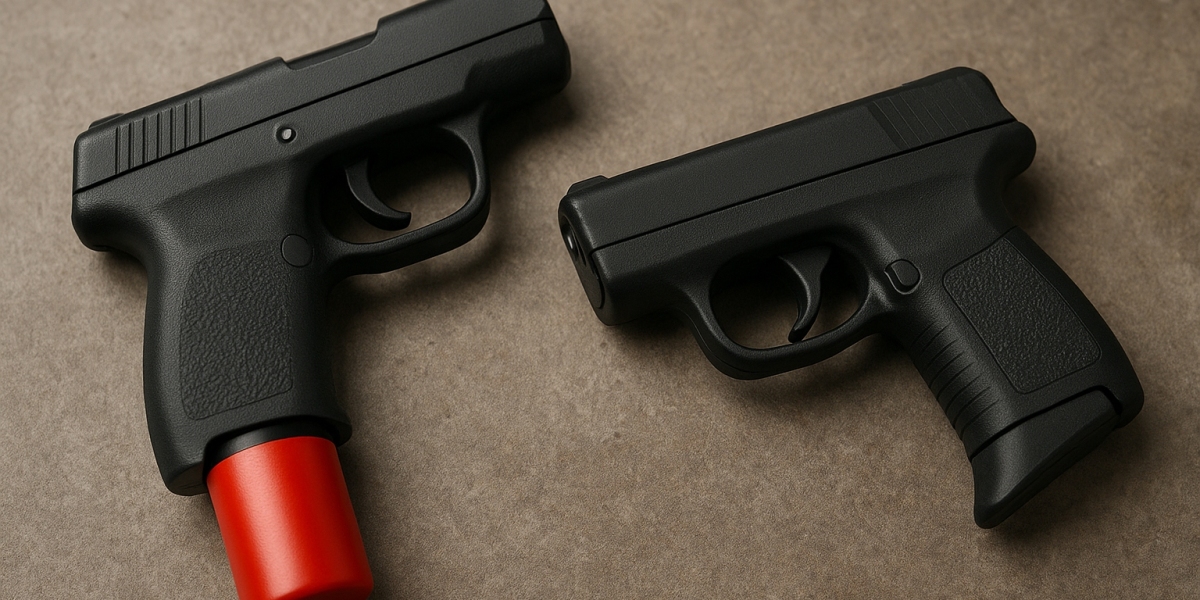Thinking about how to protect yourself is sensible. But choosing the right tool requires balancing legality, effectiveness, safety, and personal comfort. Two categories people commonly consider are blank guns for self defence and the more familiar air gun. Although both look like firearms and can provide a psychological deterrent, they are very different in design, purpose and legal treatment — and each has important limits.
This comprehensive guide walks you through what blank guns and air guns actually are, how (and whether) they can be used for personal protection, legal and ethical considerations, safe handling and storage, practical alternatives, and buying and maintenance tips so you make a choice that keeps you and others safe.
What is a blank gun — design, purpose and common uses
A blank gun is a firearm-like device engineered to fire blank cartridges: cartridges that produce a loud report and muzzle flash but do not propel a projectile (bullet) downrange. The primary purposes of blank-firing devices are theatrical effects, starter pistols in sport, training, and signaling. They mimic the look, weight and operation of a real firearm without firing a projectile — which is why they’re sometimes chosen for deterrence or alarm.
Key characteristics:
Fires blank ammunition only (no projectile under normal use).
Produces a loud sound and visible muzzle flash.
Often uses a semi-automatic or single-shot action.
Some models are designed to accept sound suppressors or conversion kits — modifications that may be illegal in many places.
Because they create noise and flash similar to live firearms, blank guns can startle an attacker and draw attention, but they are not inherently lethal in their intended form. They can be effective as psychological deterrents or to call for assistance — provided they’re used lawfully and with caution.
What is an air gun — types and how they differ from blanks
The term air gun covers a broad family of devices that use compressed air or gas to propel a pellet or BB. Common types include spring-piston, CO₂-powered, and pre-charged pneumatic (PCP) models. Unlike blank guns, air guns actually fire projectiles and therefore can cause injury or death if used irresponsibly.
Key differences from blank guns:
Air guns propel physical projectiles (pellets or BBs), so they have kinetic energy and terminal effects.
Power ranges widely — from low-energy pistols for casual plinking to high-energy rifles suitable for pest control or small-game hunting.
Air guns are often regulated differently than blank guns; in some jurisdictions they are treated like firearms if they exceed a certain muzzle energy.
Air guns can be used legitimately for sport, pest control and, in limited contexts, hunting. Using them for self-defence is legally and ethically complex.
Understanding those distinctions helps you choose the correct device for your needs and avoid legal trouble.
Effectiveness for self-defence — expectations and limitations
It’s crucial to be realistic. Neither blank guns nor most air guns are a guaranteed solution for personal safety.
Blank guns for self defence
Strengths: Loud report and muzzle flash can startle an attacker, cause hesitation, attract attention, and create an opportunity to escape. They are easy to carry and relatively simple to operate.
Limitations: No projectile -> no stopping power. At close range, the muzzle blast can cause burns or temporary injury, but it’s unreliable as a means to incapacitate an attacker. An assailant under the influence of substances or with intent to harm may not be deterred.
Air guns for self defence
Strengths: Fire projectiles that can cause pain or injury; powerful models can stop an aggressive animal or deter a human attacker. Less conspicuous than a firearm in some situations.
Limitations: Legal restrictions (power limits, use against people), accuracy and stopping power at close range can be variable, and using lethal force carries serious legal and moral consequences. In many places firing a projectile at a person is subject to the same laws as firearms.
In short: blank guns can be useful as a deterrent or alarm; air guns are potentially more physically effective but come with higher legal and safety responsibilities.
Legal and ethical considerations — non-negotiable
Before purchasing or carrying either device, verify your local laws. Regulation varies significantly by country, state, or municipality:
Possession and carrying rules: Some jurisdictions fully prohibit blank guns or treat them like firearms; others allow ownership but restrict public carry.
Use-of-force laws: Discharging any device at a person can amount to assault or worse; claiming “self-defence” is evaluated against local standards (reasonable force, imminent threat, proportionality).
Modifications and conversions: Converting a blank gun to fire projectiles, or converting an air gun to exceed legal power limits, is illegal in many jurisdictions and extremely dangerous.
Public display and misrepresentation: Brandishing a realistic replica in public can lead to criminal charges, panic, or police response.
Ethically, consider whether carrying a deterrent is consistent with your values and willingness to accept responsibility for unintended consequences. When in doubt, consult local law enforcement or legal counsel.
Safety, training, and safe storage
Owning such tools makes safety training essential.
Training
Learn local laws and self-defence statutes.
Take a basic self-defence course focused on avoidance, de-escalation, and escape.
If you decide to own a device, get hands-on training for safe handling, quick deployment, and safe storage.
Safe handling
Treat every device as if it can cause harm. Even blank cartridges can expel hot gas and debris at close range, and air gun projectiles can penetrate skin and eyes.
Never point at people unless lawfully defending yourself and no other options exist.
Use quality holsters or secure carry methods to prevent accidental discharge.
Storage
Secure storage is critical: locked container, unloaded, separate from ammunition.
Keep devices out of reach of children and unauthorized users.
Follow local rules for securing weapons or replicas in the home.
Practical scenarios — when a blank gun or air gun might be chosen
City commuter seeking non-lethal deterrent: A blank gun or personal alarm can provide a psychological deterrent and attract attention without the legal complexity of a firearm.
Rural property owner concerned about pests/animals: A high-powered air gun (where legal) is a legitimate tool for pest control; it is not primarily a self-defence device against humans.
Event security and signaling: Blank guns and flares are frequently used for signaling or crowd control in theatrical or sporting contexts.
Always evaluate risks: could brandishing or firing escalate the threat? Will police response to a gun-like device put you or others at risk? Consider those scenarios ahead of time.
Alternatives and complementary measures for real safety
Tools are only one part of a safety plan. Consider these proven, lower-risk options as part of a layered approach:
Situational awareness and avoidance: The most effective self-defence tactic is preventing risky situations.
Personal alarms and whistles: Portable, legal, and effective at attracting attention.
Pepper spray / incapacitating sprays: Legal in some jurisdictions; non-lethal and can stop an assailant long enough to escape (check local laws).
Self-defence training and conflict de-escalation classes.
Home security improvements: Better lighting, cameras, reinforced doors and locks reduce risk.
Buddy systems / safe travel planning: Avoid isolated routes at night; share location with someone trusted.
These options are safer and often more legally straightforward than depending on a weapon-like device.
Buying guide — what to consider if you proceed
If, after careful consideration, you decide to buy:
For blank guns
Purchase from reputable retailers and confirm the model is legal for ownership and carry in your area.
Prefer models with safety locks and a clear safety mechanism.
Avoid any parts or advertised conversion kits that turn blanks into projectile-firing firearms — these are often illegal.
For air guns
Choose calibre and power appropriate for intended legal uses (plinking, pest control).
Check muzzle energy ratings and local legal thresholds.
Buy from established suppliers, and get a gun that comes with a reliable warranty and access to service parts.
In both cases, consider budget for appropriate carrying accessories, secure storage, training and safety equipment.
Maintenance and responsible ownership
Regularly inspect mechanisms, clean per manufacturer recommendations, and replace worn seals on air guns.
For blank guns, ensure the chamber and barrel are free of obstructions and use correct blanks only.
Follow the manufacturer’s maintenance schedule, keep manuals, and never attempt unauthorized modifications.
Responsible ownership reduces accidents and ensures the tool will function as expected when needed.
Conclusion — a realistic, legal, and safety-first approach
Neither blank guns for self defence nor an air gun should be selected lightly. Blank guns offer a powerful psychological deterrent and an immediate signaling function but lack reliable stopping power. Air guns fire projectiles and therefore carry far greater ethical and legal responsibility. The smartest approach blends prevention (awareness, safe routines), legal knowledge, training, appropriate non-lethal tools, and, only when fully lawful and responsibly managed, a device that fits your real needs.
If you choose to own either, do the legal homework first, commit to training and safe storage, and think through how possession affects not just your safety but the safety of family and the public.
Frequently Asked Questions (FAQ)
1. Are blank guns legal to carry for self-defence?
Legality varies widely. Some jurisdictions permit possession but restrict carrying in public; others ban blank-firing devices or treat them like firearms. Always check local laws and consult authorities before purchasing or carrying one.
2. Can firing a blank gun injure someone?
Yes — at very close range muzzle blast, hot gases and debris can cause burns, eye injuries or other harm. Never assume blank guns are harmless: maintain safe distances and avoid pointing at people.
3. Are air guns effective for self-defence?
Air guns can deliver painful or injurious shots, but using them against people entails serious legal and ethical consequences. They are primarily designed for sport, pest control and hunting — assess legality and use of force laws before considering them for defence.
4. Is modifying a blank gun to fire projectiles legal?
In many places, converting a blank gun into a live-fire weapon or increasing the power of an air gun is illegal and dangerous. Modifications that bypass safety features can create criminal liability and severe risk of injury.
5. What’s a safer alternative to carrying a gun-like device?
Personal alarms, pepper spray where legal, self-defence training, improved situational awareness and safe travel practices are effective, legally simpler options that reduce risk without escalating violence.
6. How should I store these devices at home?
Store unloaded in a locked container, with ammunition stored separately, keys controlled and access restricted to authorized adults. Proper storage reduces theft risk and accidental use by children or visitors.









